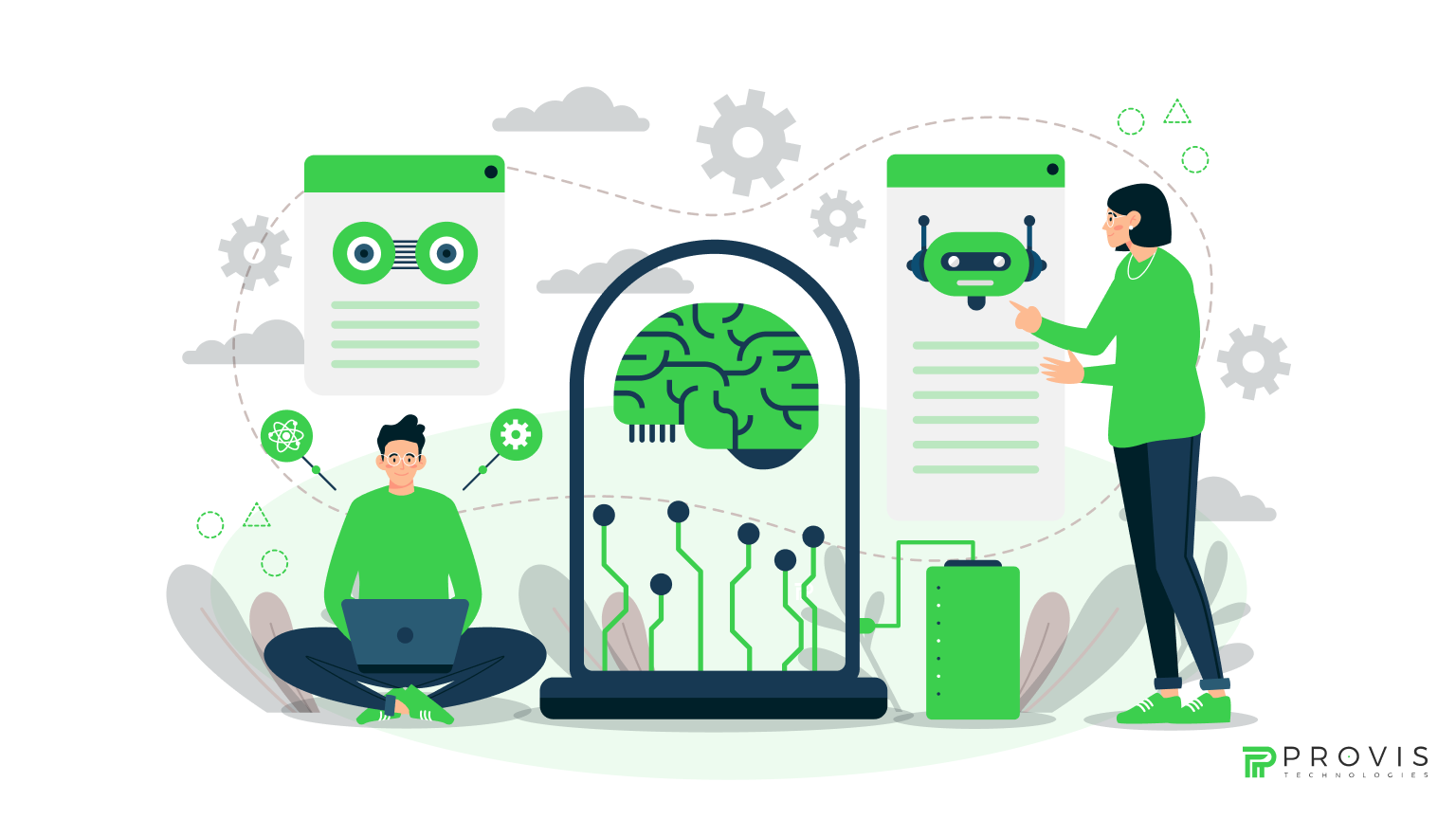The interaction between humans and technology through artificial intelligence (AI) requires prompt engineering, which is the most vital approach to AI effectiveness.
AI Prompt Engineering involves developing clear, structured instructions that lead AI models to produce superior outputs. Moreover, AI prompt engineering is a skill that professionals use in content creation, software development, business automation, and customer support roles.
The development of advanced AI systems has made prompt engineering techniques more complex, which allows users to achieve better efficiency and accuracy from their AI-generated outputs.
This blog from Provis Technologies reveals all aspects of AI prompt engineering guide in 2025, including best practices and advanced methods. It also includes tools, realistic uses, and projections for the future.
What is AI Prompt Engineering?
AI prompt engineering refers to a systematic input development process that produces commands for AI models to produce high-quality, valuable responses.
Prompts exist in two forms:
- Basic Questions
- Complicated instructions with document formatting rules
Quality-designed input instructions produce superior AI outcomes, which require fewer revision rounds and improve work speed.
The Importance of AI Prompt Engineering
A good prompt engineering guide helps AI capabilities reach their maximum potential.
Distributing prompts enables AI to generate superior responses and cut production time while improving creativity, enabling better business execution.
Refining prompts helps users reduce bias while guaranteeing more accurate results and content that fulfills their expected output. Similarly, businesses employing prompt engineering technology in marketing, education, healthcare, and finance use it to automate operations and enhance their decision-making processes.
Suggested Read: Benefits Of AI Integration
Best Practices for Effective Prompt Engineering
Clarity and Specificity
The clearer the AI prompt design, the better the response. Rather than vague instructions, include direct and specific text.
For instance, “What are some marketing strategies?” The amount of information may result in generic results, or even specifying “Explain five digital marketing strategies for small businesses in 2025” will result in more specialized responses.
Providing Context
Narrowing down the scope helps in the context of AI, which further generates the relevant response.
A tiny “Write about climate change” is too general.
In contrast, a long “Write a 500-word blog post about how climate change impacts agriculture with a special emphasis on drought and soil erosion” is more specific.
Role-Based Prompting
Prompting AI to play a particular role can better deliver expert-level responses.
For example, if your prompt is “Act as a cybersecurity expert and explain ransomware attacks in simple terms,” you will get a more authoritative and structured explanation.
Iterative Refinement
AI responses won’t be perfect on the first attempt. By integrating more details into the prompt, changing the scope, or, more precisely, underlying the angle, results begin to improve.
Prompt engineering is an iterative process that requires prompts to be iterated through trial and error.
Types of AI Prompts
Informational Prompts
This AI prompt engineering guide require knowledge-based responses.
Examples are “Describe the relevance of quantum computing for AI” and “Condense the internet’s history in 200 words.”
Creative Writing Prompts
By specifying the goal of the creative content that AI should produce, whether or not it is “writing a short story about an astronaut discovering a new planet” or “a poem about autumn leaves falling”, you can provide guidelines to the AI to generate that creative content.
Business and Marketing Prompts
AI is used for content marketing in business, lead generation, customer engagement, and other purposes.
Some examples are “Create a LinkedIn post on the advantages of using AI for customer service” or “Draft an email campaign promoting a new fitness app.”
Conversational AI and Chatbot Prompts
AI chatbots have prompts to help with user interaction. This includes “Simulate a chatbot conversation assisting a customer with a laptop return request” and “Create response for a virtual assistant giving travel recommendations.“
Advanced Prompt Engineering Techniques
Chain-of-Thought Prompting
The advantage of this technique is that it encourages AI to interpret a problem in logical steps.
Say, “How do machine learning models work?” A better prompt would be: ”Explain the three simple steps machine learning models do.”
Few-Shot and Zero-Shot Learning
Zero-shot learning requires AI to produce an output without any active previous examples, while in few-shot learning, AI goes for a first sample and then asks for the output. Imagine a few-shot prompt like “Here are three examples of product descriptions.”
Instead, generate one for wireless headphones. A zero-shot prompt would be, “Write a convincing product summary about a smart thermostat.”
Multi-Turn Prompting
Here, the response is refined in a few iterations of prompts. For instance, “Draft an article introduction and now offer three improvements.“
Negative Prompting
Negative prompts in an AI prompt engineering guide teach AI what not to produce. For example, “Describe AI ethics but not data privacy” guarantees a response that meets the user’s needs.
Challenges and Solutions in AI Prompt Engineering Guide
Ambiguous Responses
If the prompt is not clear enough, AI could generate void responses. The first solution is to give the AI structured and detailed instructions.
Bias and Inaccuracies
There are times when AI delivers biased or incorrect information. For instance, users should also provide neutral context, fact-check AI-inputted content, and adapt prompts so the responses are balanced.
Generic Outputs
If an output of AI lacks depth, then writing prompts that specify the desired level of detail can help. For example, asking for “a detailed analysis” instead of “a summary” quality of response is better.
Long Processing Time
Prompts in an AI prompt engineering guide that are too complex lead to delayed response. Prompt length by keeping things concise, but doing so without losing too much detail can actually be helpful.
The Future of AI Prompt Engineering
As AI evolves, so will prompt engineering as it advances in several key areas. AI systems would get to use automated AI prompt optimization, optimizing prompts based on previous interactions to get accurate responses. This will make AI more usable by accepting text, image, and voice commands at the same time, i.e., multimodal prompts.
As AI becomes more effective, industry-specific AI language model prompting can be applied to fields such as healthcare, finance, and law.
Furthermore, no-code AI will enable more users to benefit from AI-driven processes without needing to write a single line of code (non-technical users).
The Bottom Line
In AI prompt engineering guide 2025, it is a crucial skill that permits users to optimize AI’s underpinnings in numerous fields. By using prompt engineering best practices, trying advanced techniques, and embracing the right tools, professionals can make the most of AI to boost creativity, efficiency, and innovation.
However, as AI technology advances, it’s necessary to keep up with the most recent prompt engineering strategies to obtain the totality of what AI has to give. Mastering AI prompts, regardless of whether you are a content creator, developer, marketer, or business leader, will definitely put you at a competitive advantage in the digital era.
Written By
Author's Picks
Categories
- AI for Startups
- AI in Web Development
- AI Integration
- AI Platforms
- AI Prompt
- AI Tools
- AI Trading Software
- Android App
- Android vs iOS Development
- Angular
- API
- API Development
- App
- app development
- App Idea
- App User Feedback
- Application
- Artificial Intelligence
- Audit Services
- Automotive Industry
- Awards and Recognition
- Business Consulting
- Business Website
- Chatbots
- CRM
- CRM for Financial Advisors
- Custom CRM
- Custom SaaS
- Custom Website
- Customer Service
- dashboard design
- Developing a Mobile App
- Digital Business
- E-commerce
- EMR Integration
- Finance
- Financial Advisors
- Financial Advisors
- GIT
- Health Insurance
- iOS App
- iOS App Development
- IoT Mobile App Development
- IoT Platforms
- IT Audit Services
- IT Consulting
- IT Strategies
- Java Development
- Laravel
- Lean Canvas
- Learning Management System
- Logistics Apps
- Mobile App Development
- MVP
- Native App
- News Aggregator Site
- OTT
- Outsourcing IT
- Payment Gateway
- predictive analysis
- Product Launch Strategy
- Progressive Web App (PWA)
- Prototype
- Recommender Systems
- Ruby
- SaaS
- SaaS Application
- SaaS Business
- SaaS Company
- SaaS Development
- SaaS Product
- SaaS Project
- Sales Funnel
- SEO
- Shopping Cart
- Software Development
- SSL and TLS
- Startup Checklist
- Technology
- Tetradic Color Scheme
- UI/UX Design Company
- Unit Testing
- User Flow
- User Testing
- Web Development
- Web Performance Optimization
- website Maintenance Services
- Website Migration Service
- Website Speed Optimization
- WooCommerce
- WordPress





